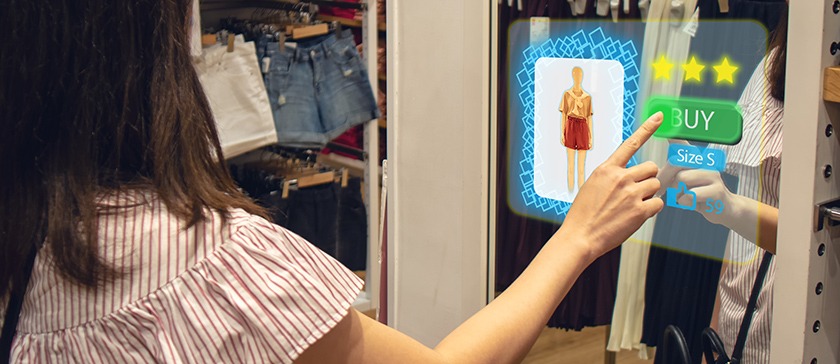Tara is a democratic shopper. When she went shopping last December, she did not stop trying on a few pieces she liked. She encouraged her friends who had accompanied her to vote for each piece to help her buy what most preferred.
She did the same when she shopped last week. Staying safe at home, she simply logged in, picked what she liked, tried those on virtually and shared the images socially for a poll. Then and only then did she place the order online.
At the other end of Tara’s transactions are shops that had the option of forgoing business until the lockdown lifted and fears dissipated. However, business can’t wait. They took to augmented reality (AR) and bypassed the in-person sales roadblock altogether. In the process, they discovered a route that can supplement (and even boost) the traffic the main road is likely to deliver as and when it opens.
In play even before
The virus did not spawn AR. It was in play long before, thanks to the many practical advantages it offered and still does.
Let us begin with Tara’s favorite shops. They do not have to maintain changing rooms. Nor do they need a large physical inventory and a fleet of employees to gather and rearrange items tried and discarded by customers. They now maintain a digital catalogue and are finding it faster and easier to adapt their sales strategy to the online, social market.
One of the early uses of AR was to bring static elements to life. Point your camera at the magazine ad and your phone will start playing a short film that would tell you more about the brand. Focus on the movie poster and the dinosaurs of Jurassic Park will lunge at you.
Taking it further, Hyundai created an augmented manual for drivers. When you “Ask Mercedes” something about your car, the augmented interface will tap the power of AI and give you a quick answer.
How can the tedious experience of waiting for a bus make you reach for a Pepsi? Because Pepsi had converted the walls of the bus stop using AR to depict captivating movie-like visuals. You might miss your bus, but you are unlikely to miss telling your friends about the wall that Pepsi brought to life.
Adding value to B2B marketing
AR may provide an engaging experience in consumer marketing, but it has great utility even in the B2B domain.
Imagine you are selling a complex product to a demanding client. AR can help your customers see and interact with the product, just the way they want—from drone’s viewpoint to up close and even through (cross-section). When you leave nothing to the imagination in a room full of decision makers, it becomes a lot easier for you to close the deal, without flying them all the way to your factory.
Does your customer want a say in the very design of the product or its customization? AR makes it easy for all to see the what-if scenario, making it possible to visualize the advantages and the otherwise unanticipated problems. That helps you make productive use of WYSIWYG (what you see is what you get).

As seasoned marketers know, customer loyalty is won or lost more after the sales than during. When the customer has no time to flip through the pages or scroll infinitely in search of the solution they seek, AR can provide a show-and-tell solution that is more likely to ensure a repeat order than a fat discount.
“Camera marketing” must be thought through
In a pre-corona report published in April 2018, the Boston Consulting Group (BCG) noted that “one specific form of camera marketing, the use of augmented reality (AR), is quickly gaining traction.”
It observed that AR application consumers “are a particularly attractive segment for advertisers: most are millennials (aged 19 to 34) or Generation Z consumers (aged 18 or younger).
They use their smartphones and cameras continually throughout the day, communicating via images and video as much as they do through text and voice. This behavior opens up an entirely new method for engaging with consumers—an interactive approach where the advertiser is a participant in the ‘conversation’ or activity rather than a company delivering a message.”
BCG noted that market maturity was the biggest challenge reported by marketers today in the adoption of AR. Their survey threw up factors such as “unable to reach my audience at scale,” “lacks a track record of results, is too new and experimental,” and “requires too large an investment” as barriers. Today, these barriers have been largely overcome.
The report recommended a five-point plan to lay the foundation for AR marketing strategies and their successful execution. These continue to be valid even in these COVID times.
- Clearly articulate business objectives. Pick the right marketing tool that can achieve an objective most effectively and efficiently. Consider AR as a core component of your marketing portfolio.
- Pick the right platform for your AR strategy—your own or a third-party platform. You may also pick a hybrid approach for maximum impact.
- Bolster your AR development infrastructure or pick a partner who is strong in AR and has the expertise and experience to understand your marketing strategy. It is important to stay current and also take the leap to be trailblazers when the opportunity presents itself.
- Establish metrics to measure the effectiveness of your AR campaign right at the beginning. Heightened brand awareness resulting in increased sales is a better metric than a million social media likes for the wow factor.
- Consider every AR project a test. Be ready to cut losses, learn the lessons and come back stronger.
AR as experiential marketing
AR is not about dazzle or novelty. It is about an engaging experience that enhances the value on offer to the customer. It must facilitate authentic communication and meaningful interaction with the brand.
If you are trying to add a piece of furniture to or repaint your house, you can use a tape and your imagination. Or you can let AR help you place the furniture in various spots until you are happy with the position. You can think and debate colors with your spouse or AR can show your house as it would look with various colors on the walls. The moment you hit a color that shows off your furniture (that you just placed) well, just click on the button and the painters would be at your doorstep the next morning.
Instead of struggling to relate to a communication that is meant for all, AR can make the customer feel as if the entire marketing muscle behind a brand is at one’s personal service.
After all, Tara did not buy a dress or jewelry or lipstick. What she bought was the feel-good experience, how good she looked and felt, thanks to AR.
And she has picked the department store to visit now that restrictions are partially off. She has uploaded her shopping list. Once she reaches there, AR will show her the shortest route to pick up the items she needs. That will help her minimize contact with others and get out of the store quickly.
When avoid-touch is likely to remain the safe norm for some time, AR can still give your customer the virtual high of personal touch and keep your real sales flowing. Right here, right now.

